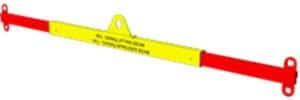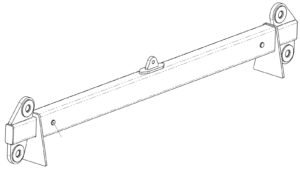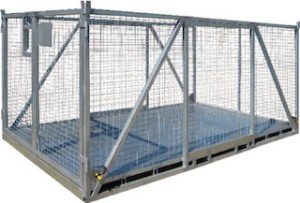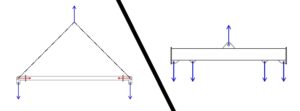
Industrial workplaces often require cranes and other lifting machinery in order to move large items with ease, however misuse and common spreader beam mistakes can result in potentially dangerous lifting accidents.
Simple crane spreader beams are designed to allow long loads to be slung evenly and safely. Crane spreader beams are triangular in shape with chains or slings connected to the end attachment points of the beam, whereas a crane lifting beam has a central lift point for the crane hook to attach. This helps minimize head height above the beam, however, being a central lifting point requires the size and strength of the beam to be much greater because the beam is not in compression; it is now in tension.
As common worksite and warehouse tools, spreader beam mistakes and misuse occur frequently and can be a serious workplace health and safety hazard.
We’ve put together a spreader beam rules guide to help you stay safe at work when using crane spreader beams and crane lifting beams.
Crane Spreader Beam Usage Rules
1. Understanding the Beam’s Purpose

The beam at the base of the spreader’s triangle holds the bulk of the load’s weight. It’s distributed between the two connection points with the chains or slings from above. The weight isn’t the only force on the spreader beam; there’s also weight generated by compression on the beam in the lifting action.
When the beam is properly set above a load, the spreader takes on the compression that would otherwise damage the lifted item. When a load is lifted and swung, the weight and compression remain on the spreader beam so that any long load, such as metal containers and boats, remain intact and damage-free.
2. Never lift a load wider than the spreader beam lift points allow
The beam’s load should never be longer than the beam lifting points because the beam has strength in compression. Put simply, the lifting points should always suspend the load vertically. Picture a pipe or cylinder being held end to end by the spreader. The beam suspends a few feet above the load, which creates a parallel formation between the two items.
If this load is longer than the beam itself, than the load’s force and compression is drawn onto itself. The spreader beam is essentially taken out of the equation.
3. Rig your spreader beam correctly
As an example, if you were to hoist a large rectangular load, the safest way to set the chains or slings is to have a two leg chain sling below each end of the spreader beam lifting points. This creates a four leg lift to the rectangular load by lifting the load in each corner and avoids unnecessary load swing.
The other alternative is using a single leg chain below each end of the spreader beam to lift a large diameter pipe for example. In this case, the four leg chains are not required and add cost and complexity to the rigging of the spreader beam.
4. Always Distribute the Load Evenly
Misuse and safety compromises result from loading the spreader beam in the wrong manner. The load must be evenly distributed between both sides of the beam. Without a balance, several issues can occur, such as:
- Unnecessarily straining the beam’s hook mechanism
- Compromising the stability of the lift
- Damaging the load
Irregularly shaped loads should be evaluated prior to lifting them. Consider an adjustment of the beam’s hook locations.
You can also use spreader beams that have the ability to telescope over the lengths required. For example, a four metre closed spreader beam can telescope out to six metres in the open position.
5. Ensure you have the correct load calculation
Workers in the immediate area can be severely injured if the load’s weight isn’t properly calculated into the lift, which is a very serious spreader beam mistake. Riggers and Dogman must remember that the spreader beam’s tare weight must be allowed for prior to the crane performing the lift.
Calculate the maximum capacity with these gross weight parameters, including:
- Load TARE WEIGHT
- Spreader beam and hoist accessories (chain slings, shackles etc.) WORKING LOAD WEIGHT
The combined above weights equals your HOISTED LOAD WEIGHT.
If you leave the spreader beam out of the equation, the lift can fail with dire consequences.

6. Always Lift a Certified Lifting Device with your Spreader Beam
If you have products that need to be contained in a cage or lifting frame, and then are lifted using crane spreader beams, ensure that the lifting device has been manufactured in accordance with Australian Standard AS4991 and the manufacturer’s load weights and capacities are stamped on the device.
This will ensure that the TARE WEIGHT of the product and lifting device can be calculated into the HOISTED LOAD WEIGHT.
Products such as large crane goods lifting cages are designed for this purpose.
7. Always Store Crane Spreader Beams using Safe Storage Protocols
Every spreader beam must be properly inspected before being stored away after each use, and it is important to store beams in dry, cool conditions.
Otherwise, environmental factors such as moisture, salt air or toxic environments, could damage a beam.
8. Inspect beams every 12 months
A qualified inspector should be engaged every 12 months to inspect spreader beams, and record this inspection on your Lifting Equipment Asset Register. This inspection is in accordance with the relevant Australian Standards.
Any damages to the equipment requires it to be tagged out for non-use and repaired and inspected by a qualified technician before it can be used.
9. Understand the Difference Between crane spreader beams and crane lifting beams

It’s important to understand the difference between crane spreader beams and lifting beams so you use the right beam for the job. Anthony Cushlaw of Britlift puts it simply:
“Any beam where the load being lifted mainly puts bending stress in the beam will be referred to as a lifting beam.
Any beam where the load being lifted mainly puts a compressive stress in the beam will be referred to as a spreader beam.”
You can read an in-depth explanation of the differences between spreader and lifting beams to better understand when each should be used here.
Incorrect use of crane spreader beams and crane lifting beams is an all too common cause of industrial lifting accidents. It is important that all workers are aware of spreader beam workplace health and safety requirements, and workplaces implement best practice spreader beam safety protocols to prevent crane lifting accidents.
Always purchase spreader beams from an Australian material handling equipment supplier who manufactures to Australian standards.
Key Definitions
TARE WEIGHT – sometimes called unladen weight, is the weight of an empty vehicle or container. By subtracting it from the gross weight (laden weight), the weight of the goods carried (the net weight) may be determined. Read more about TARE WEIGHT.
GROSS WEIGHT – is the total (laden) weight of of goods, including their packaging such as crates, pallets etc.
WORKING LOAD LIMIT (WLL) – is the maximum working load designed by the manufacturer. Read more about the WORKING LOAD LIMIT.
GROSS LOAD WEIGHT – is the combined weights of all items suspended underneath the lifting hook of the crane or other lifting device.
